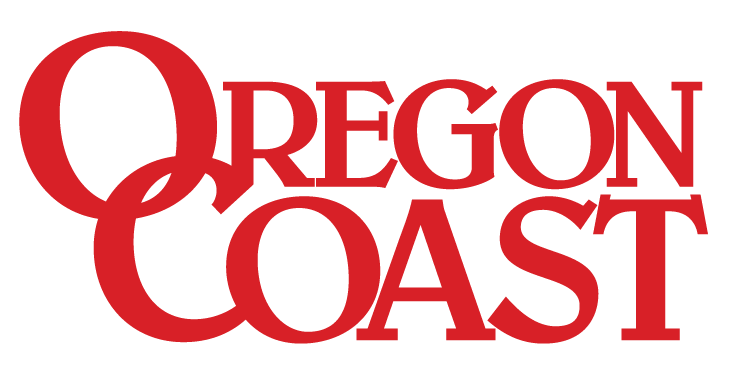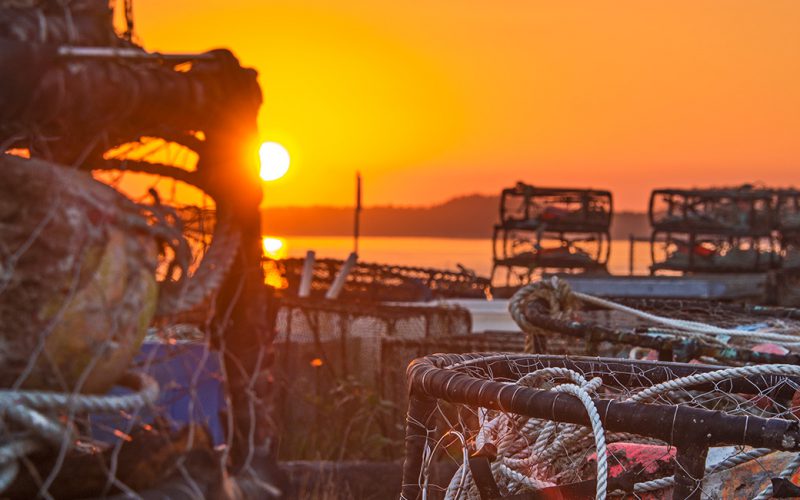It’s December in Port Orford and Christmas is coming, but an event just as important and meaningful is approaching. So much planning and months of work have gone into it—all leading to this one day.
The anticipation has been palpable and at last it is here—the opening day of Dungeness crab season. For weeks, the crab pots have been arriving, and they are stacked all around the perimeter of the dock, organized by the markings of the pot itself and the buoy attached by its coil of rope inside. There are thousands of them, stacked five high, and they are a wonder to behold. Each fisherman’s buoys are unique, by hue and design, painted with encircling rings of various widths and geometric designs in a kaleidoscope of colors. ➞
Here, at the most unique port in Oregon, the dock is abuzz with activity. For days, the fishermen have been chopping bait—thousands of pounds of fish flown in frozen from Alaska—hacking it into chunks to later be affixed to the pots. The boats have been readied, their engines tuned, and they are loaded with gear, fuel, fresh water, and food.
At midnight, three days before the season officially opens, the boats are lowered into the sea from this drydock port, the only one on the West Coast. One by one, with the massive hydraulic crane, each boat is lifted from its wooden dolly, hoisted over the port wall and down into the frigid water below. In the darkness of night, a forklift scurries to that fisherman’s trove of pots, retrieves a pallet of five and rushes to the crane at the end of the dock. The crane operator deftly hoists the pots off the pallet and over the port wall to the ship below. Back and forth scramble the forklifts, lights flashing, bringing more and more pots to the crane to be loaded onto the boat, till crab pots fill the stern of the boat. At last, the boat eases away from the dock and slowly rounds the jetty, setting course for the open sea to what are hoped to be fertile crab grounds.
And so it continues through the wee hours of the morning, until all the boats have been loaded to the hilt. It is tedious, time-consuming work, requiring much planning and great expense, but the prize is worth it. Thousands of pounds of Dungeness crab, coveted for its sweet and tender flesh, will provide income for these families for many months of the year. Last year’s harvest in this state alone was 20.4 million pounds valued at $63 million.
The ships travel out many miles and start to drop their pots. Weighing 60 to 125 pounds each and measuring up to 4 feet in diameter, it takes two men to handle them. Using the winch attached to the boat, each pot is taken from its stack and opened to attach the bait and release the buoy and its coil of rope. The pot is then closed, with the buoy laid on top, and dropped overboard from the slow-moving boat. Like robots, the crew repeats the steps until all the pots are gone from the deck.
From the stern of the boat can be seen a long line of colorful Styrofoam buoys, twisting and turning, bobbing up and down, like a costumed chorus line of dancers performing on stage. The ship returns to the dock to repeat the exercise, loading pots, traveling to their chosen spot, baiting, and dropping them. This may happen seven to 10 times over the span of two days until all the pots are used. The fishermen dock their boats and head home to sleep for 12 to 16 hours and eat heartily to regain their strength and build the energy they will need for the harvest to come.
It’s the third day and all the boats are gone again. With the season officially open, they travel to their fishing ground with great anticipation. Will it be a good year? Will the pots be filled? Will the crabs be small, or large and bursting with meat? There are no guarantees in this business, despite the fact that so many lives depend on the health of the sea and the forces of nature. Last year the harvest was delayed almost three weeks due to the Department of Agriculture finding elevated levels of domoic acid, a toxic substance created by algae in water that is too warm, in test crabs. The delay allowed the crab to spend more time in colder water to process out the acid, making them safe to eat.
Now the dock is reawakening. A large tractor-trailer filled with fish bins is being unloaded, the forklift bringing them near the crane that will relieve the returning ships of their bounty.
And there, on the horizon is a light, a ship coming home to port. Then another, and another. Eight, ten, twelve, fourteen, fifteen ships all heading this way, bright beacons in the blackness of night, to bring up the first crab of the season. And though they are moving at full throttle, it seems an eternity till they round the jetty and pull to the end of the dock, one at a time, to begin the slow process of unloading, a reversal of the steps that took place three days ago.
The fishermen, though exhausted, are exhilarated and filled with a sense of pride and accomplishment, that their long journey and hard work will be rewarded by the fish wholesaler, who will weigh their haul and pay them their due. The wives and loved ones come to the port to greet their men, welcome them home, make sure they are safe. They were lucky this year, weather-wise: no storms or high seas to hinder their efforts for opening day.
Over the next several months, the men continue to go out every couple of days to empty and rebait their pots. Though crab season officially lasts until August, 80 percent of the harvest is caught in the first eight weeks.
The frenzy is over now, the anticipation gone—even the uncertainty of how much money they will earn this season. But each season, the question remains: Will it be a good year with a record catch, like 2005–6 when 33.7 million pounds were landed, or a year like 2007–8, when storms ravaged the coast and only 12.3 million pounds were brought in? With its strict regulations regarding size, sex and season, Oregon has ensured the sustainability of the Dungeness crab fishery, as certified in 2010 by the Marine Stewardship Council, but this is a cyclical business, subject to the whims of nature (algae blooms, water temperature, currents, storms). Just look at the ups and downs on a graph of the annual landings over the past 30 years to understand how unpredictable this fishery can be.
Then talk to a commercial fisherman, who loves the sea and his profession, and get really excited about the future. Joel Purkey, of Port Orford, has been fishing for 25 years and is about to launch his new 41-foot boat—the Alice Faye—built with a 16-foot-wide beam to increase his haul. When asked about the coming season, he says, “I’m optimistic. The last two years have been good, so I think it will continue.” And if not, he isn’t concerned, because like so many fishermen, he also fishes for other species such as tuna, halibut, sablefish, lingcod, and rockfish—all bountiful in these waters. As to his being diversified, he adds, “I have to be—so many people depend on me.” ■




